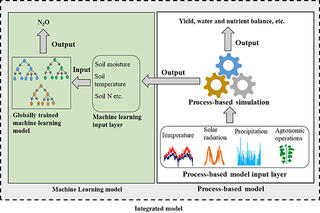Machine learning improves predictions of agricultural nitrous oxide emissions from intensively managed cropping systems
D. Saha et al. “Machine learning improves predictions of agricultural nitrous oxide (N2O) emissions from intensively managed cropping systems” Environmental Research Letters 16, 2 (2020) [DOI: 10.1088/1748-9326/abd2f3]
The potent greenhouse gas nitrous oxide (N2O) is accumulating in the atmosphere at unprecedented rates largely due to agricultural intensification, and cultivated soils contribute ~60% of the agricultural flux. Empirical models of N2O fluxes for intensively managed cropping systems are confounded by highly variable fluxes and limited data; process-based biogeochemical models are rarely able to predict daily to monthly emissions with > 20% accuracy even with site-specific calibration. Here we show the promise for machine learning (ML) to significantly improve field-level flux predictions, especially when coupled with a cropping systems model to simulate unmeasured parameters. We used sub-daily N2O flux data from six years of automated flux chambers installed in a continuous corn rotation at a site in the upper U.S. Midwest (~3000 sub-daily flux observations), supplemented with weekly to biweekly manual chamber measurements (~1100 daily fluxes), to train an ML model that explained 65-89% of daily flux variance with very few input variables –soil moisture, days after fertilization, soil texture, air temperature, soil carbon, precipitation, and N fertilizer rate. When applied to a long-term test site not used to train the model, the model explained 38% of the variation observed in weekly to biweekly manual chamber measurements from corn, and 51% upon coupling the ML model with a cropping systems model that predicted daily soil N availability. This represents a 2-3 times improvement over conventional process-based models and with substantially fewer input requirements. This coupled approach offers substantial promise for better predictions of agricultural N2O emissions and thus more precise global models and more effective mitigation management interventions.
Data and R code are available on Dryad.
